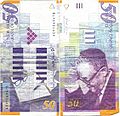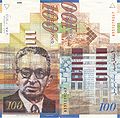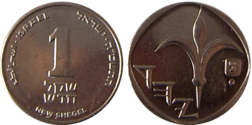Israeli new shekel
| Israeli new shekel | |||
|---|---|---|---|
| שקל חדש (Hebrew) شيقل جديد (Arabic) |
|||
|
|||
| ISO 4217 Code | ILS | ||
| User(s) | |||
| Inflation | 3.9% (2009 est.) 3.5% (2008 est.) | ||
| Source | The World Factbook, 2007 | ||
| Subunit | |||
| 1/100 | agora | ||
| Symbol | ₪ | ||
| Plural | shekalim (pronounced shkalim) | ||
| agora | agorot | ||
| Coins | 10 agorot, ½, 1, 2, 5, 10 new shekalim | ||
| Banknotes | 20, 50, 100, 200 new shekalim | ||
| Central bank | Bank of Israel | ||
| Website | bankisrael.gov.il | ||
The Israeli New Shekel (Hebrew: שקל חדש, Shekel Ḥadash) (sign: ₪; acronym: ש״ח and in English NIS; code: ILS) (also spelled sheqel; pl. shekalim pronounced shkalim - שקלים, Arabic: شيقل جديد, shiqel jadid or شيكل جديد shikel jadid) is the currency of the State of Israel. The shekel is divided into 100 agorot (אגורות) (sing. agora, Hebrew: אגורה). Denominations made in this currency are marked with the shekel sign.
Contents |
History
The old sheqel suffered from runaway inflation during the economic crisis which occurred in Israel in the early 1980s. After inflation was finally contained by the middle of the decade as a result of the 1985 Economic Stabilization Plan, the new sheqel was introduced, replacing the old sheqel on January 1, 1986 at a rate of 1,000 old sheqalim = 1 new sheqel.
Since January 1, 2003, the sheqel has been a freely convertible currency. Since May 7, 2006, sheqel derivative trading has also been available on the Chicago Mercantile Exchange.[2] This makes the sheqel one of only twenty or so world currencies for which there are widely-available currency futures contracts in the foreign exchange market. It is also a currency that can be exchanged by consumers in many parts of the world.[3][4]
On May 26, 2008, CLS Bank International (CLS Bank) has announced that it will settle payment instructions in Israeli New sheqel, thus making this currency fully convertible.[5]
The currency is not produced in Israel, as the country has no mint. Currently, the coins are minted at Korea Minting and Security Printing Corporation (KOMSCO), the banknote and coin producer of South Korea, while the banknotes are produced in Switzerland.
For a wider history surrounding currency in the region, see The History of British Currency in the Middle East.
Coins
In 1985, coins in denominations of 1, 5 and 10 agorot, ½ and 1 new sheqel were introduced.[6] In 1990, 5 new sheqalim coins were introduced,[7] followed by 10 new sheqalim in 1995.[8] Production of 1 agora pieces ceased in 1990 too, and they were removed from circulation on April 1, 1991. A 2 new sheqalim coin was introduced on December 9, 2007.[9] The 5 agorot coin, last minted in 2006, was removed from circulation on January 1, 2008.[10]
Circulation coins of the sheqel are:
| sheqel coin series | |||||||||
|---|---|---|---|---|---|---|---|---|---|
| Value | Technical parameters | Description | Date of | ||||||
| Diameter | Thickness | Mass | Composition | Edge | Obverse | Reverse | issue | withdrawal | |
| 1 agora | 17 mm | 2 g | Aluminium bronze 92% copper 6% aluminium 2% nickel |
Smooth | Ancient galley, the state emblem, "Israel" in Hebrew, Arabic and English | Value, date | September 4, 1985 | April 1, 1991 | |
| 5 agorot | 19.5 mm | 1.3 mm | 3 g | Smooth | Replica of a coin from the fourth year of the war of the Jews against Rome depicting a lulav between two etrogim, the state emblem, "Israel" in Hebrew, Arabic and English | January 1, 2008 | |||
| 10 agorot | 22 mm | 1.5 mm | 4 g | Smooth | Replica of a coin issued by Mattathias Antigonus (37 - 40 B.C.E.) with the seven-branched candelabrum, the state emblem, "Israel" in Hebrew, Arabic and English | Current | |||
| ½ new sheqel | 26 mm | 1.6 mm | 6.5 g | Smooth | Lyre, the state emblem | Value, date, "Israel" in Hebrew, Arabic and English | Current | ||
| 1 new sheqel | 18 mm | 1.8 mm | 4 g | Cupronickel 75% copper 25% nickel[11] |
Smooth | Lily, "Yehud" in ancient Hebrew, the state emblem | Value, date, "Israel" in Hebrew, Arabic and English | September 4, 1985 | Current |
| 2 new sheqalim | 21.6 mm | 2.3 mm | 5.7 g | Nickel bonded steel | Smooth with 4 regions of grooves | Two cornucopia, the state emblem | December 9, 2007 | Current | |
| 5 new sheqalim | 24 mm | 2.4 mm | 8.2 g | Cupronickel 75% copper 25% nickel |
12 sides | Capital of column, the state emblem | January 2, 1990 | Current | |
| 10 new sheqalim | 23 mm Core: 16 mm |
2.2 mm | 7 g | Ring: Nickel bonded steel Center: Aureate bonded bronze |
Reeded | Palm tree with seven leaves and two baskets with dates, the state emblem, the words "for the redemption of Zion" in ancient and modern Hebrew alphabet | Value, date, "Israel" in Hebrew, Arabic and English | February 7, 1995 | Current |
| For table standards, see the coin specification table. | |||||||||
- Note that all dates on Israeli coins are given in the Hebrew calendar and are written in Hebrew numerals.
Banknotes
In September 1985, banknotes were introduced in denominations of 1, 5, 10, 20 and 50 new sheqalim. The 1, 5 and 10 new sheqel notes used the same basic designs as the earlier 1,000, 5,000 and 10,000 old sheqel notes but with the denominations altered.
In 1986, 100 new sheqel notes were introduced, followed by 200 new sheqel notes in 1991. The 1, 5 and 10 new sheqel notes were later replaced by coins. A plan to issue a 500 sheqel banknote, carrying the portrait of Yitzhak Rabin, was announced shortly after Rabin's assassination in 1995. However, due to low inflation rates, there was no need for such a banknote, and it was never issued. However, in February 2008 the Bank of Israel announced that the planning of an entirely new series of banknotes has started, and that the new series, to be issued in 2010, will most probably include a 500 sheqel banknote as well. The design of the new banknotes has not yet been determined, but if the 20 new sheqel polymer banknote of the current series, introduced in April 2008, is successful, the new series will almost certainly consist of polymer notes only. Possible designs under review are: non-political famous personalities, such as Teddy Kollek (former mayor of Jerusalem), Rabbi Shlomo Goren ( Former IDF chief chaplain), Ilan Ramon (Israel's first astronaut who died at the Columbia in 2003), Naomi Shemer (song writer), . Other possible designs may include landscapes, flora and fauna of Israel. Reports in December 2009 indicated that the new bills, to be issued in 2012, would bear the images of Theodor Herzl, David Ben-Gurion, Menachem Begin, and Yitzhak Rabin, with the portrait on the 500 Sheqel bill to be determined.
Notes currently in circulation are:
| Second Series of the New sheqel | ||||
|---|---|---|---|---|
| Value | Dimensions | Colour | Obverse | Reverse |
| 20 sheqel | 71x 138 mm | Green | Moshe Sharett | Jewish volunteers in World War II; a watchtower, commemorating tower and stockade settlements |
| 50 sheqel | Purple | Shmuel Yosef Agnon | Agnon's notebook, pen and glasses, Jerusalem and the Temple Mount | |
| 100 sheqel | Brown | Yitzhak Ben-Zvi | Peki'in Synagogue | |
| 200 sheqel | Red | Zalman Shazar | a street in Safed and text from Shazar's essay about Safed | |
The 20 sheqel banknote is the first, as of April 2008, to be made of polypropylene, a polymer substrate, which is superior to the current paper note with a circulation life of a few months only. The polymer note is printed by Orell Fuessli Security Printing of Zürich, Switzerland. 1.8 million of the new banknotes were printed with the writing "60 years [anniversary] of the State of Israel" (in Hebrew), in red ink.
|
Gallery
_Obverse_&_Reverse.jpg) 20 shekel bill |
 50 shekel bill |
 100 shekel bill |
 200 shekel bill |
Abbreviation
In Hebrew the new shekel is usually abbreviated ש"ח (pronounced shaḥ). The symbol for the new shekel, ₪, is a combination of the first Hebrew letters of the words shekel (ש) and ḥadash (ח). According to the standard Hebrew keyboard (SI 1452) it must be typed as AltGr-A (the letter ש appears on the same key in regular Hebrew mode). However, in Windows XP it can be typed on the default Hebrew keyboard by pressing AltGr-4 (while Shift-4 produces the dollar sign), however the sign does not appear on the physical keys of most keyboards that are used in Israel and is rare in day-to-day typing. In Arabic, the currency is usually denoted by the abbreviation ش.ج which is the initials of šikel jadīd, the currency's name in Arabic.
| Current ILS exchange rates | |
|---|---|
| From Google Finance: | AUD CAD CHF EUR GBP HKD JPY USD |
| From Yahoo! Finance: | AUD CAD CHF EUR GBP HKD JPY USD |
| From XE.com: | AUD CAD CHF EUR GBP HKD JPY USD |
| From OANDA.com: | AUD CAD CHF EUR GBP HKD JPY USD |
See also
- Sheqel
- Economy of Israel
- Shekel sign
References
- ↑ According to Article 4 of the 1994 Paris Protocol [1]. The Protocol allows the Palestinian Authority to adopt additional currencies. In West Bank the Jordanian dinar is widely accepted and in Gaza Strip the Egyptian pound is often used.
- ↑ Chicago Mercantile Exchange Press Release (2006-04-06). "CME to Launch Foreign Exchange Contract on Israeli Sheqel". http://www.cme.com/about/press/cn/06-45sheqel18024.html.
- ↑ Israelis can soon travel the world with sheqels in their pockets Haaretz
- ↑ sheqel begins trading on global markets Jerusalem Post
- ↑ CLS Press Release (2008-05-26). "CLS Bank live with Israeli sheqel and Mexican Peso". http://www.cls-group.com/news/article.cfm?objectid=127EC3A9-F263-C9E9-19BE3E0623DCF229&origin=26E70E8A-14C7-4247-BC9E9B0B321D4D68.
- ↑ "About the Agora and New Sheqel Series". Banknotes and Coins Catalog. Bank of Israel. http://www.bankisrael.gov.il/catal/eng/cat_all_eng.htm?series_num=25&series_name=Agora%20and%20New%20Sheqel%20Series. Retrieved 2007-12-26.
- ↑ "5 NEW SHEQALIM". Banknotes and Coins Catalog. The Bank of Israel. http://www.bankisrael.gov.il/catal/eng/bill_all_eng.htm?series_num=25&series_name=Agora%20and%20New%20Sheqel%20Series&pg_name=c040&pg_kot=5%20NEW%20SHEQALIM. Retrieved 2007-12-26.
- ↑ "10 NEW SHEQALIM". Banknotes and Coins Catalog. The Bank of Israel. http://www.bankisrael.gov.il/catal/eng/bill_all_eng.htm?series_num=25&series_name=Agora%20and%20New%20Sheqel%20Series&pg_name=c041&pg_kot=10%20NEW%20SHEQALIM. Retrieved 2007-12-26.
- ↑ "Press Release:The new NIS 2 coin". The Bank of Israel. 2007-07-08. http://www.bankisrael.gov.il/press/eng/070708/070708e.htm. Retrieved 2007-12-26.
- ↑ "Abolishment of the 5 agorot coin." (in Hebrew). The Bank of Israel. 2008-01-01. http://www.bankisrael.gov.il/press/heb/080101/080101m.htm. Retrieved 2008-01-01.
- ↑ Note that nickel-clad steel 1 new sheqalim coins were issued in 1994 and 1995
External links
- Bank of Israel catalogue of Israeli currency since 1948
- Exchange rates since 1948
- American Israel Numismatic Association
- Israel Government Coins and Medals Corporation
- Current Shekel Dollar Rate
- Shekel coins with pictures
- Shaar yatzig - Official Rate gadget
|
|||||||||||||||||||||||

_Obverse.jpg)
_Reverse.jpg)